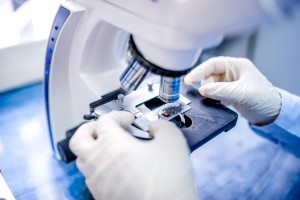Complete Blood Count (CBC) abnormalities can indicate anemia, infection, inflammation or blood cancer
Blood Serum Chemistry Profile includes kidney function, liver enzymes, electrolyte levels (and more). Abnormalities can indicate poor organ function, diabetes and even cancer
Thyroid Level (T4) is important for overweight or underweight animals that may be hypo or hyper thyroid.
Feline leukemia/Feline AIDS is recommended for any new cat in your household to protect other cats in your home. If your outdoor cat becomes ill, viral testing is recommended as they may have had contact with viral positive cats without us knowing.
Wellness testing can be preformed at any time, however most clients choose to make it a part of their pet’s annual examination. Some of the information that wellness test provide us with include: a Complete Blood Count (CBC) and Biochemistry Profiles.
Specific Gravity test (or concentration) helps determine whether your pet’s kidneys are functioning, based on the concentrating factor of the urine. This test will tell whether your pet is dehydrated, or excreting too much water. Chemical Test Strips can detect the presence of blood, protein, glucose or other substances. Microscopic exam allows your veterinarian to look for blood cells, bacteria and crystals. Crystal formation can be associated with urinary tract inflammation, infection, or stone formation that can potentially lead to urinary blockages (especially common in male cats). Urinalysis can help determine which type of crystals are present, in order to develop an effective treatment plan and diet for your pet.
Fecal flotation tests identify eggs of intestinal parasites such as hookworms, whipworms, tapeworms and protozoa such as coccidia and giardia. These organisms can cause diarrhea and are shed in the feces to be passed onto other animals (or sometimes humans) that come into contact with the feces. An examination of fecal material can also uncover the presence of intestinal bleeding and verify suspected problems with nutrient assimilation. Evidence of salmonella infection, campylobacteriosis, corona virus and other diseases that affect digestion can also be found in the feces.
Pathology is the study and diagnosis of disease through examination of organs, tissues, bodily fluids and whole bodies. Our veterinary specialists can tell us about the lumps and masses that are removed from your pet. In obtaining a proper diagnosis, the veterinary health care team is able to help your pet by using the treatment plan that is best suited of their individual condition.
Often our doctors will elect to send these samples to a specialist to be sure they are properly identified.
Radiography (x-rays) – allows us to visualize the internal structures of your pet’s body. It can help us identify any broken or fractured bones, a foreign object that your pet may have ingested, vital organs that may be enlarged or reduced in size and masses or fluid within the abdomen or chest cavities.
Uses a non-invasive, non-painful tool for the diagnosis and staging of many diseases. Ultrasound is the best modality to evaluate fluid filled areas and soft tissue organs; it allows us to visualize the internal architecture of many organs and can identify any abnormal masses or heart problems.
